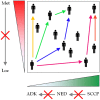Prostate cancer and neuroendocrine differentiation: more neuronal, less endocrine?
- PMID: 25785244
- PMCID: PMC4347593
- DOI: 10.3389/fonc.2015.00037
Prostate cancer and neuroendocrine differentiation: more neuronal, less endocrine?
Abstract
Neuroendocrine differentiation (NED) marks a structural and functional feature of certain cancers, including prostate cancer (PCa), whereby the malignant tissue contains a significant proportion of cells displaying neuronal, endocrine, or mixed features. NED cells produce, and can secrete, a cocktail of mediators commonly encountered in the nervous system, which may stimulate and coordinate cancer growth. In PCa, NED appears during advanced stages, subsequent to treatment, and accompanies treatment resistance and poor prognosis. However, the term "neuroendocrine" in this context is intrinsically vague. This article seeks to provide a framework on which a unified view of NED might emerge. First, we review the mutually beneficial interplay between PCa and neural structures, mainly supported by cell biology experiments and neurological conditions. Next, we address the correlations between PCa and neural functions, as described in the literature. Based upon the integration of clinical and basic observations, we suggest that it is legitimate to seek for true neural differentiation, or neuromimicry, in cancer progression, most notably in PCa cells exhibiting what is commonly described as NED.
Keywords: chromogranin A; interleukin-6; neural differentiation; neuroendocrine differentiation; prostate cancer.
Figures






References
Publication types
Grants and funding
LinkOut - more resources
Full Text Sources
Other Literature Sources
Research Materials

